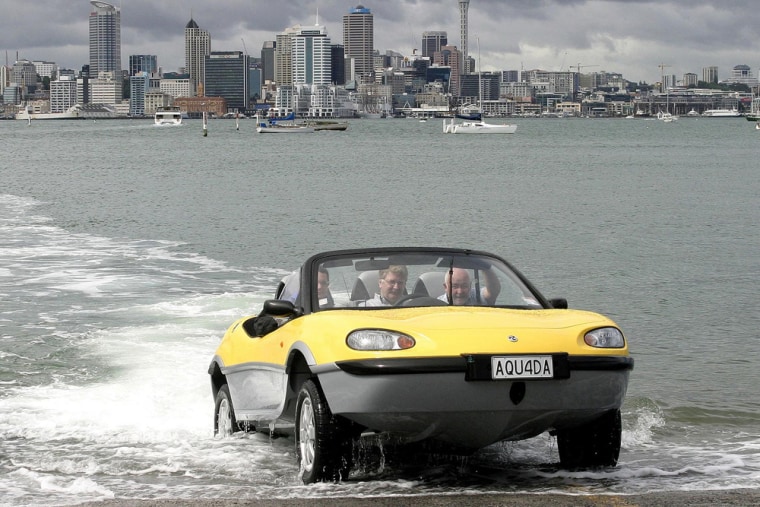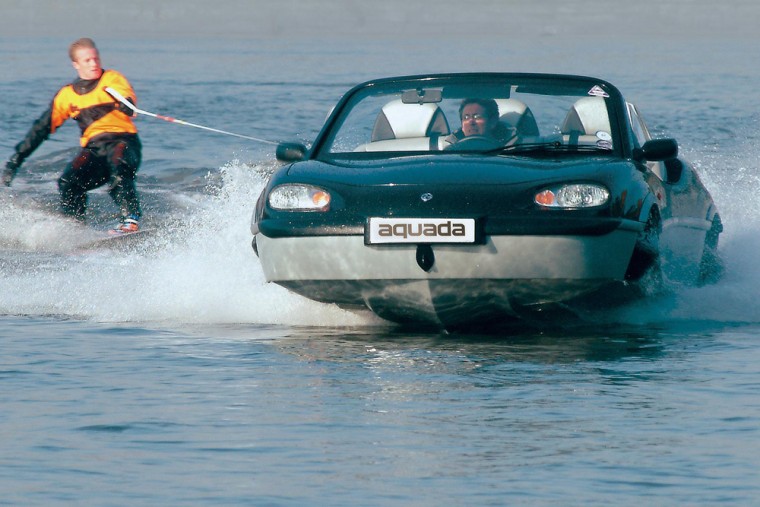Have you ever wished that you could drive through the river to avoid the traffic? Well, maybe soon you can.
Gibbs Technologies Ltd. is about to begin marketing the Aquada, a vehicle with what it calls “amphibian” technology. With just the press of a button, this sporty convertible becomes a speedboat.
The Aquada is expected to be available in the U.S. in 2009 with a price tag of $85,000, according to Holly Clark of AutoCom Associates, Gibbs’ public relations firm. The company arrived at that price by considering the cost of a motor boat and the truck and trailer typically needed to pull it, Clark said. A small fleet of pre-production models were sold in Europe in 2003, where the price exceeded $200,000.
Gibbs, which is based in the U.K., plans to move its production to the U.S. and open three companies here. One of them, Gibbs Amphibians, would manufacture the Aquada. Currently, 10 of its Aquadas are being tested in Michigan by Gibbs engineers.
The company says the vehicle can simply be driven right into the water. It takes about five seconds for the wheels to retract and for the power to switch from a four-cylinder, 175-hp V6 engine to water-jet propulsion.
“There is a second of panic when you drive the car into the water,” Clark said, “and then it is so much fun!”
But keep in mind that some waterways may require a boat license.
The vehicle, which has a five-speed automatic transmission, can go up to 100 mph on land, and up to 30 mph on water (enough oomph to tow a water skier). It supposedly transitions from water to land just as easily as it does from land to water.
The Aquada has three seats and the steering wheel is in the middle of the dashboard. The driver sits in the center, slightly forward from the other two seats. There is no grille, for obvious reasons. All venting to the engine is from the top. There are no doors either (all the better to perfect your cool hop-in-the-car move).
The company said the vehicle was the product of a seven-year development program, more than one million man-hours, and 60 newly patented technologies. Many challenges had to be overcome in the creation of the vehicle. For example, the aerodynamics of a boat are different than that of a car; if the front of a car were lifted like the bow of a boat, the car would flip at high speeds. A white light shining backwards on a boat is mandatory, but a white light shining backwards on a car is forbidden.
Alan Gibbs, the company founder, built his first amphibious car in New Zealand in 1995 because he wanted to go boating on his holiday property without a truck and trailer. He started Gibbs Technologies in 1996 in Detroit and moved the company to the U.K. in 1999.

He said in a press release that developments in lightweight materials, engine technology and vehicle architecture made the Aquada possible.
He also said he expects that 100,000 high-speed amphibious vehicles similar to the Aquada could be sold annually in the U.S. within five years, based on his company’s market research. That would make it the first land-and-water vehicle to be commercially successful.
Alexander Edwards, an automotive research analyst with Strategic Vision, said that 100,000 units per year in the U.S. is a “very optimistic view.” He cited the fact that sales of all automobiles currently available in the $85,000 price range is about 100,000 units per year. He also pointed out that there are about 115,000 “active” boaters in the U.S., defined as those who use their boats everyday, in some cases for transportation.
“There are a lot of factors and, in the end, it will be about how much prestige the vehicle has,” Edwards said. “If the Aquada is really cool, the company might be able to reach that sales mark eventually.”
Looking at the recreational boating industry, the numbers — and market potential — seem much larger. According to the most recent data from the National Marine Manufacturers Association, about 10.6 million motor boats smaller than 26 feet in length were registered in the U.S. in 2005. This excludes personal watercraft and sailboats.
There are places in the world where the Aquada could be really useful, such as in countries with poor road infrastructure, Edwards said, but in those places, people likely won’t be able to afford the $85,000 price tag.
"Since the late 1890s, there have been literally hundreds of attempts to build a commercially viable amphibious vehicle," said Gibbs in the press release. "The Magrelen Amphibium built in Denmark in 1899 is credited with being one of the first motorized attempts, while the Hobbycar produced in France between 1992 and 1995 was one of the last."
Porsche built an estimated 5,000 Type 166 Schwimmwagens between 1940 and 1944. Hans Trippel manufactured and sold nearly 4,000 Amphicars during the 1960s. The U.S. government produced thousands of amphibious vehicles during World War II. None were capable of speeds of more than 7 mph on water. Over the past decade, the U.S. military has been developing a high-speed amphibious personnel carrier that uses water-jet propulsion. But its deployment has been pushed back and budgets blown because of reliability issues, according to the Washington Post.
Gibbs is headquartered in Nuneaton in the U.K., but decided to move its production to the U.S. after Rover, the company that built engines for Gibbs in the U.K., went out of business.
Besides Gibbs Amphibians, it plans to open two other companies here: Gibbs Sports Amphibians would manufacture and sell the Quadski, an all-terrain vehicle. Gibbs Military Amphibians would work with Lockheed Martin to produce high-speed amphibian (HSA) military vehicles.
Gibbs Amphibians and Gibbs Sports Amphibians are expected to begin new model production late next year. Gibbs said it has openings in engineering, manufacturing, finance, human resources and sales, and plans to hire more than 1,500 employees in the U.S. within three years. Hiring for key management positions began in May.
Detroit, Georgia, Texas, Virginia and Miami, Florida are being considered for the new companies’ homes in the U.S., Clark said. A decision on the locations is expected to be made within a few months.
Gibbs said there is no limit to the kinds of vehicles that can be amphibious and it hopes to have an amphibious minivan soon.
Gibbs and Lockheed Martin already have created a military concept vehicle that they expect to unveil later this summer — it’s called the Humdinga.
